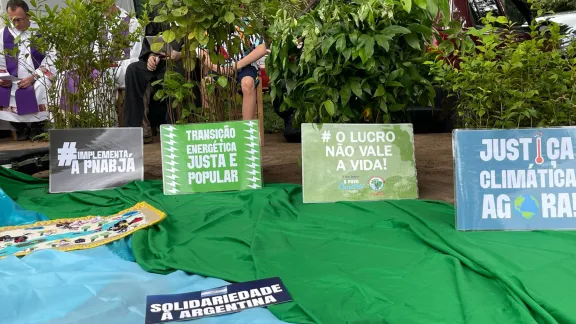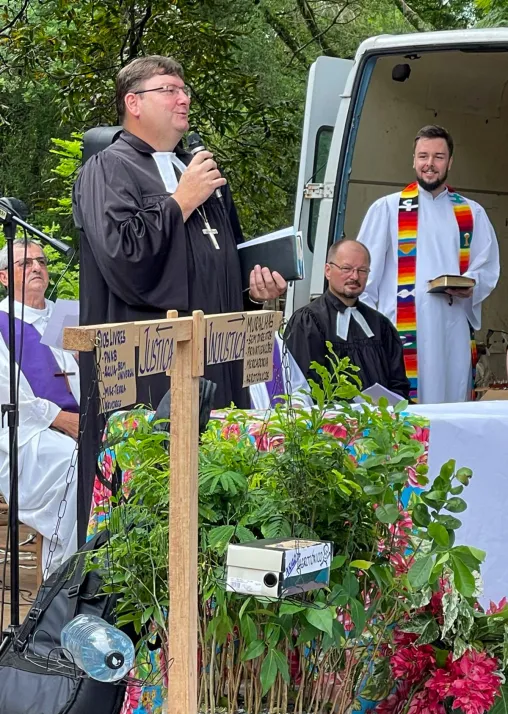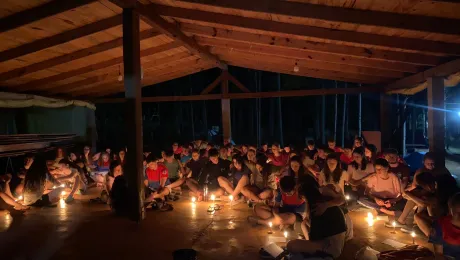LWF member churches in Latin America have advocated for “Free Rivers,” criticizing the environmental and social impacts caused as well as the amount of land that large dams and industrial plants use along the Uruguay River.

Posters calling for a just energy transition respecting the rights of people and creation. Photo: IECLB
Churches advocate for the rights of communities along the Uruguay River
(LWI) - “Water for Peace” is the theme for the 2024 UN World Water Day observed on 22 March. “We must act upon the realization that water is not only a resource to be used and competed over – it is a human right, intrinsic to every aspect of life,” states the UN Water.
The Lutheran Federation (LWF) member churches and ecumenical partners in the countries along the Río Uruguay, a major river in South America, have advocated for “Free Rivers” – Ríos Libres – since the 1980s. They criticize the environmental, land-use and social impacts that large dams and industrial plants cause along the river.
“Even though we are now witnessing the pain caused by the changes in natural cycles, bringing death and destruction on all sides and for all people, especially the most socioeconomically fragile, our hope is in the empty cross, in the resurrection, in full and abundant life,” said Rev. Fábio Rucks from the Evangelical Church of the Lutheran Confession in Brazil (IECLB).
He preached on 9 March during the 7th Binational Ecumenical Celebration for Free Rivers. The event took place in the border region between Brazil and Argentina, where the Uruguay River joins the two countries at Porto Lucena, Brazil.
Participants came from the IECLB, Evangelical Church of the River Plate (Argentina/Uruguay), United Evangelical Lutheran Church (Argentina/Uruguay), and the Diocese of Santo Ângelo of the Catholic Church (Brazil).
The Río Uruguay is about 1,800 kilometers long and forms parts of the borders of Brazil, Argentina and Uruguay. Its primary economic use is the generation of hydroelectricity. For that, that river is dammed in its lower portion by the Salto Grande Dam, a reservoir completed in 1979, covering a surface area of 783 square kilometers, and shared by Argentina and Uruguay, and by the Itá Dam upstream in Brazil, completed in 2000 and covering a surface area of 141 square kilometers. The electricity these plants generate significantly contributes to these nations’ energy supply.
Mega-dams infringing on people's rights
There are plans to build two more mega-dams in the Uruguay River between Argentina and Brazil. “The Garabí-Panambi Hydroelectric Complex has caused controversy over the environmental impact on the fast-flowing river,” explains Rucks. In 2015, the environmental licensing process for the Panambi plant was suspended with a court ruling. “That was a great success for our advocacy efforts.”

Rev. Fábio Rucks from the IECLB preaching during the 7th Binational Ecumenical Celebration for Free Rivers. Photo: IECLB
In addition to environmental impacts, these dams generally affect small farmers, peasants, the landless, indigenous people, fisher people, “ribeirinhos” (communities that live along the riverbanks), and “quilombolas” (black communities), mineral miners, as well as urban populations, Rucks explains.
He said that churches have advocated for “Free Rivers” together with civil society organizations such as the “Movement of those Affected by Dams” (Movimento dos Atingidos por Barragens) that fights to guarantee the rights of these populations, principally to land and calling for a new, alternative, popular energy model for Brazil.
Water as a tool for peace
For water to be a “tool for peace”, UN Water calls for a human rights-based approach to water management. The various actors at the community, national and transboundary levels must “ensure the effective participation of rights holders”, particularly of the communities living adjacent to water bodies, “to prevent internal and cross-border conflicts”.
Rucks is convinced that a lot remains to be done: “Let us not lose heart,” he said in his “Free Rivers” sermon. “Let us sit in the shade of the trees along the river. Let us pray, let us dream, let us fight.”
According to UN Water, the benefits of uniting around water could be “delivering safe drinking water and sanitation, enhancing food security, sustaining healthy livelihoods and ecosystems, helping to address resilience to climate change, contributing to disaster risk reduction, [...] and fostering regional integration and peace.”


